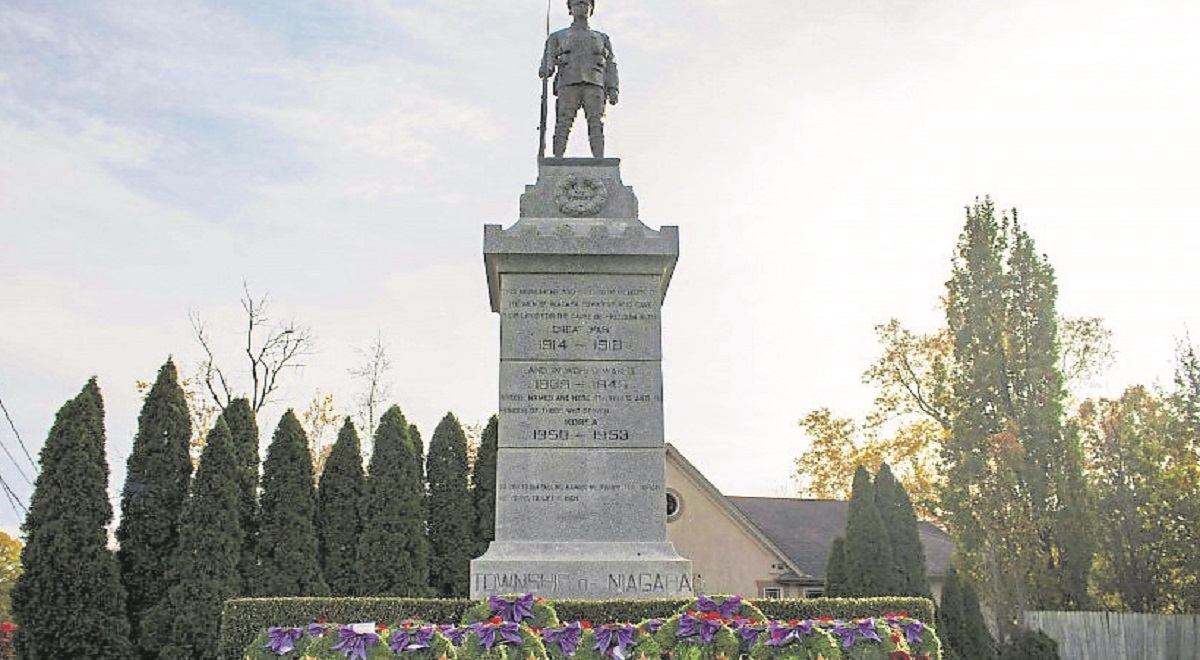THE fascinating story of a Lifford man who fought and died for Canada in the First World War has been unearthed by an Ontario historian.

Frederick Leggatt features as part of Ron Dale’s series ‘The Monuments Men’ which charts the lives of those listed on the Queenston Municipal Memorial.
During his research Ron discovered not only Leggatt’s history but the fact that his name is actually misspelled on the cenotaph. He hopes that it can be put right in honour of the man who left his beloved Donegal in 1893 and who perished in the Second Battle of Passchendaele in 1917.
It is a century since a clock tower cenotaph was erected in the southern Ontario town of Niagara-on-the-Lake. In 1926 a second memorial was unveiled in the nearby village of Queenston.
In recognition of those who fought and died in two world wars and beyond, Ron Dale, pictured below, has been researching the stories of the people – all men – whose names are engraved on the two cenotaphs.
One of the names inscribed on the municipal cenotaph in Queenston presented a bit of a mystery to the Niagara-on-the-Lake historian.
Frederick Leggatt’s name is spelled incorrectly on the monument as ‘Legatt’ although in any surviving documents the name is spelled with a double ‘g’.
Born in Lifford on December 23 1893, Fred was the son of Charles Leggatt and Mary Jane Thorn.
His parents were grocers and wine and spirit merchants in Lifford. His father died in 1910 and Mary continued to run their shop with the help of her children.
In 1913 Fred emigrated to Canada while his mother moved to Belfast. He found his way to the small Canadian community of Virgil where he secured work as a clerk in a construction firm.
On February 4 1916 Fred travelled to the city of St Catharines and enlisted in the 49th Overseas Battery of the Canadian Field Artillery.
He had no previous military experience but was determined to “do his bit” for king and country.
Like so many other young men he was rapidly trained as a soldier and soon shipped to England for deployment in Europe. He took the train to Halifax from Toronto where he boarded a steamer, disembarking in Liverpool on September 22 1916.
He was transferred from the 49th Battery to the 16th Brigade at Milford Camp in Witley, England.
A Canadian Field Artillery veteran noted, “Witley is in an ideal situation for the training of artillery. It is surrounded by large areas of rolling common land covered with gorse and heather, giving opportunities for the most extensive manoeuvres. The soil is principally sand, easy to excavate when practicing the construction of gun pits and adequate cover is available for the purpose of concealment.”
Unfortunately, when soldiers who trained there went into action in France and Belgium, they did not find the ground so agreeable. They had to dig trenches and gun pits in the water-logged clay and chalk of Flanders or the Somme.
Leggatt and his comrades trained in basic trench warfare and in getting their artillery pieces manoeuvred into position, loaded and fired.
The men practiced moving shells to pits dug near their guns. They learned the characteristics and use of the various types of artillery projectiles, whether they were high explosive, shrapnel or poison gas shells.
After seven months of preparation, Leggatt was finally sent to join the Canadian Corps units fighting in Belgium and France.
He arrived in France on April 7 1917 and was assigned as a gunner to the 83rd Battery of the 5th Brigade, Canadian Field Artillery.
Artillery was the most lethal weapon of the First World War. Guns were continually fired at enemy trenches and gun positions.
In preparation for attacks the artillery would pound enemy positions for several days prior to sending the infantry “over the top”to cross no man’s land in an assault on the enemy trenches.
The artillery fire was used to destroy enemy trenches, clear barbed wire and destroy enemy gun emplacements. Its ultimate aim though was to kill, maim or demoralise enemy soldiers. And while Canadian artillery was raining death on German positions, the enemy was firing back.
Leggatt survived the Battle of Vimy Ridge, the Attack on La Coulotte and the Battle of Arleux in April. He came out unscathed from the Third Battle of the Scarpe in May and the Battle of Hill 70 in August 1917.
But his luck finally ran out in November during the Second Battle of Passchendaele, part of the Third Battle of Ypres.
His gun was dug in just northeast of Zonnebeke in West Flanders, Belgium. On November 3 1917 while his gun was firing shell after shell at German lines an enemy shell struck his position.
Frederick Alexander Leggatt became the only Virgil resident killed in the First World War.
He is buried in the Vlamertinghe Military Cemetery in Belgium and is commemorated on the cenotaph in Queenston.
Speaking to the Donegal News Ron Dale said that perhaps at some point in the future, when the Queenston memorial is next refurbished, another ‘g’ can be added to the fallen Irish man’s surname.
“What spurred me to write these pieces was a project to refurbish our cenotaph in Niagara-on-the-Lake,” said Ron.
“Our town is part of a larger municipality also called Niagara-on-the-Lake and this incorporates the village of Queenston which also has a cenotaph.
“The one in the old town of Niagara-on-the-Lake is for men from the town while the one in Queenston is for the men of the township.
“Each year on November 11 services are held at both cenotaphs and the names of those who made the supreme sacrifice read out.
“It struck me that they are just names and I thought it would be worthwhile writing a bit about each man.
“I have uncovered a few errors in spellings and I would be hopeful that the corrections can be made at some point in the future.”







